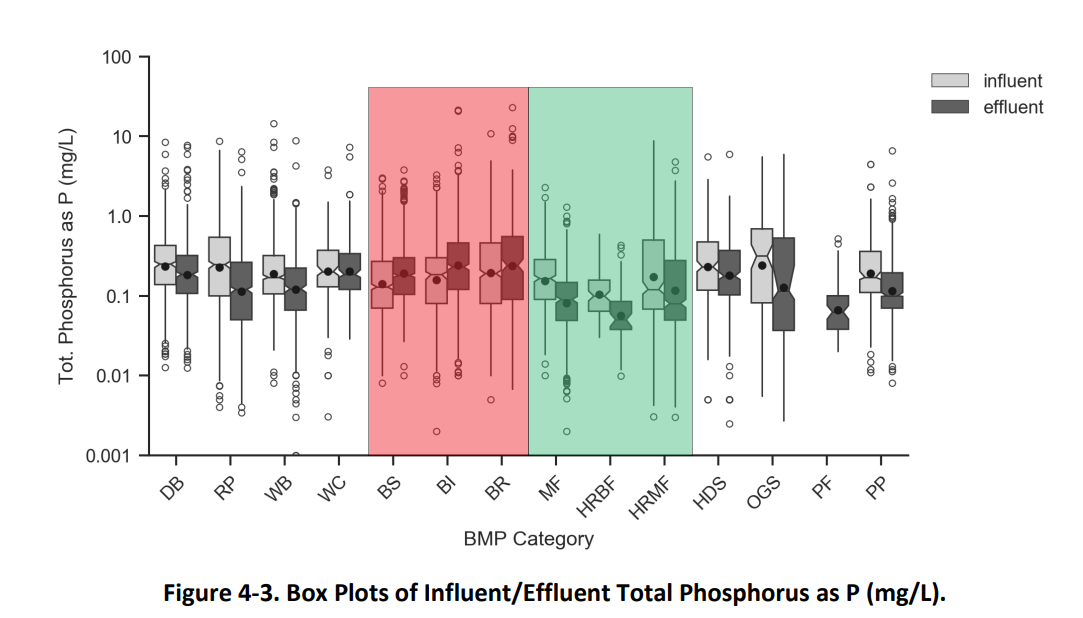Bioretention has been the principal form of Low-Impact Development (LID) used to slow, treat, retain and infiltrate stormwater runoff, mimicking a site's natural, pre-development hydrology.
One aspect of bioretention that has some scientists and regulators concerned is the phenomenon known as nutrient leaching. Nutrient leaching occurs when the bioretention media, which often contains compost, breaks down and releases phosphorus to downstream receiving waters.
The International Stormwater BMP Database (SBMPD)1 is a repository of BMP field studies and related web tools, performance summaries, and monitoring guidance. Managed by The Water Research Foundation, the project's purpose is to provide scientifically sound information to improve the design, selection and performance of urban stormwater BMPs.
The ISBMP’s newest summary statistics report was published in 2020 and included two new categories; high-rate biofiltration and high-rate media filtration. High-rate biofiltration refers to Manufactured devices with high rate filtration media that support plants. High Rate Media Filtration refers to Manufactured devices with high rate filtration media consisting of a variety of inert and sorptive media types and configurations (e.g., cartridge filters, upflow filters, membrane filters, vertical bed filters).

Traditional green infrastructure such as grass swales (BS), grass strips (BI), and bioretention (BR) shown in figure 1 all show an export of total phosphorus, as shown by median effluent concentrations that are higher than influent concentrations. This means these systems are more likely to export phosphorus than remove it which is troubling, especially in where those stormwater control measures are installed to protect nutrient-sensitive receiving waters.
The results for media filtration (MF), high-rate biofiltration (HRBF) and high-rate media filtration (HRMF) are quite different. These systems do an outstanding job of removing TP, as shown by the significantly reduced effluent concentrations. Therefore, if your goal is to meet or exceed phosphorus discharge goals, this data suggests that specifying conventional or high-rate filtration or high-rate bioretention in leu of conventional green infrastructure practices may be a better solution.
It's important to note that these summary data sets include a wide variety of system sizes and designs within most categories. For example, the bioretention category is mostly comprised of systems using a soil media blend comprised of sand and compost or topsoil, but the category also includes some systems using media alternatives like coconut coir and water treatment residuals that may provide better nutrient removal performance. Similarly, the media filtration category is mostly comprised of sand filters but includes some data from sand filters with iron amendments that are much better at removing phosphorus. At this point, the HRBF category is entirely comprised of Filterra data and the HRMF category is comprised of a variety of proprietary filters with both inert and chemically active media.
There are opportunities for design optimization for nutrient removal within all stormwater control measure categories. While the ISBMP summary statistics can be useful to identify the general type of system that is most likely to perform well for a given pollutant, it’s important to look at the specific design and sizing characteristics of monitored systems to understand how design decisions can affect performance.
Although it has primarily been used to evaluate proprietary systems, the Technology Assessment Protocol – Ecology (TAPE) program provides peer-reviewed field performance verification of any specific SCM design. Recently the Washington State Department of Ecology issued a General Use Level Designation for Basic Treatment and Phosphorus Treatment for the “City of Bellingham Phosphorus Optimized Stormwater Treatment Two-Chamber System”, a nonproprietary media filtration system that can support plant growth. This system was developed by the City of Bellingham specifically for use in phosphorus-limited watersheds. This approval brings the total number of Ecology-approved phosphorus removal technologies to 17.
While conventional green stormwater infrastructure systems like grass swales, grass strips and bioretention provide a host of benefits, phosphorus control is not one of them, unless atypical designs are used or unless there is very high potential for runoff reduction via infiltration. With a wide range of proprietary and public domain media filters and optimized biofilters available that have been demonstrated to be effective for phosphorus removal, we can and should do better than implementing run-of-the-mill green stormwater infrastructure systems in phosphorus-limited watersheds.
References:
1 https://bmpdatabase.org/
TAPE program:
https://ecology.wa.gov/Regulations-Permits/Guidance-technical-assistance/Stormwater-permittee-guidance-resources/Emerging-stormwater-treatment-technologies#tape
City of Bellingham approval
https://fortress.wa.gov/ecy/ezshare/wq/tape/use_designations/BELLINGHAMpostGULD.pdf